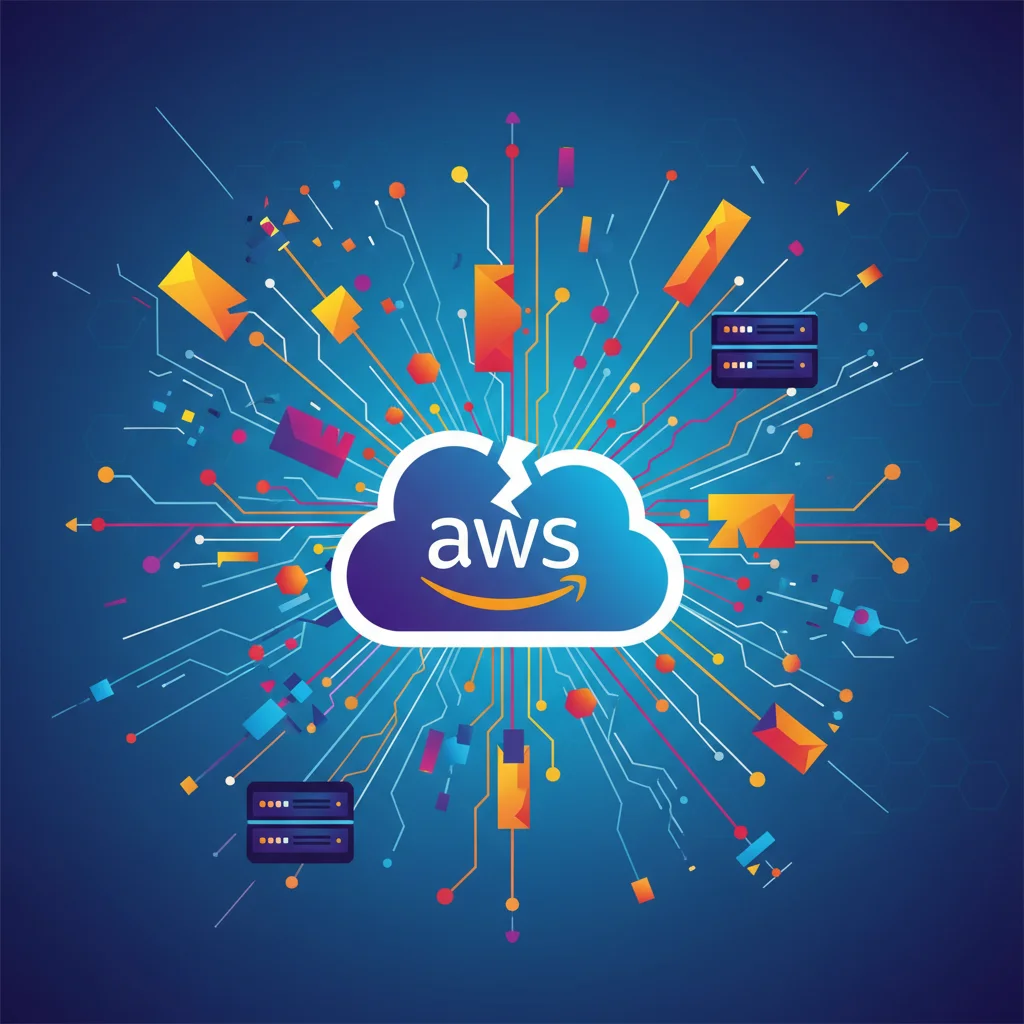
The Day the Internet Stood Still: Deconstructing the AWS Outage and Our Digital Future
Did your favorite streaming service suddenly refuse to load? Did your work collaboration tools grind to a halt? Or maybe your smart home devices decided to take an unscheduled nap? If you felt a tremor in the digital world recently, you weren’t alone. A massive outage at Amazon Web Services (AWS) sent ripples across the internet, a stark reminder of how fragile our interconnected world can be. The incident impacted over 1,000 companies and affected millions of internet users, but the real story isn’t just about a single technical glitch. It’s about the invisible architecture that underpins our modern economy and the systemic risks we’ve accepted for the sake of convenience and innovation.
This wasn’t just a minor inconvenience; it was a digital earthquake. And to understand why it made the internet fall apart, we need to look under the hood of the cloud itself.
The Invisible Backbone: What is AWS and Why Does It Run the World?
For many, the “cloud” is an abstract concept—a magical place where photos and files live. But in reality, the cloud is a physical network of massive, powerful data centers owned by a handful of giant corporations. The undisputed king of this realm is Amazon Web Services (AWS).
Think of it this way: a few decades ago, if a company wanted to launch a website or a piece of software, it had to buy, set up, and maintain its own physical servers. This was incredibly expensive, slow, and inefficient, especially for startups. AWS changed the game by allowing companies to “rent” computing power, storage, and a vast suite of other services on demand. This pay-as-you-go model fueled a decade of explosive technological growth, enabling everything from Netflix’s streaming empire to the latest AI-powered app on your phone.
Just how dominant is AWS? They command a staggering portion of the global cloud infrastructure market. According to recent data from Synergy Research Group, AWS holds a market share of around 31% (source), making it the foundational layer for a huge chunk of the internet. When AWS sneezes, the entire digital economy catches a cold.
The Cascade Failure: How One Glitch Topples a Thousand Dominoes
The core reason an AWS outage has such a wide “blast radius” is the deeply interconnected nature of modern digital services. It’s a concept known as the dependency chain. A single application you use likely doesn’t run entirely on its own; it relies on dozens of other third-party services for things like payments, analytics, customer support, and data processing. And very often, those third-party services *also* run on AWS.
This creates a cascade effect. When a fundamental AWS service like S3 (Simple Storage Service) or EC2 (Elastic Compute Cloud) has a problem, it doesn’t just take down the companies that use it directly. It also takes down all the *other* companies that depend on those initial companies. It’s a teetering Jenga tower, and AWS is the block at the very bottom.
To illustrate just how far-reaching these impacts can be, consider the various types of services that can be affected simultaneously:
| Service Category | Example Impact of an AWS Outage |
|---|---|
| E-commerce & Retail | Shopping carts fail, product images won’t load, payment processing halts. |
| Streaming & Media | Videos buffer endlessly or refuse to play, music libraries become unavailable. |
| SaaS & Productivity Tools | Project management boards go offline, communication platforms crash, code repositories are inaccessible. |
| Artificial Intelligence & Machine Learning | AI-powered features in apps stop working, model training jobs are terminated, data analysis pipelines break. |
| Internet of Things (IoT) | Smart home devices become unresponsive, security cameras go dark, connected thermostats fail. |
Under the Hood: What Really Causes These Digital Meltdowns?
While Amazon’s official post-mortems are often filled with technical jargon about “networking device impairment” or “subsystem configuration issues,” these outages typically boil down to a few common culprits. The irony is that the very systems designed to manage immense complexity can also become the source of catastrophic failure.
Here are some of the usual suspects:
- The “Fat Finger” Problem: A surprisingly common cause is a simple human error. A developer pushes a flawed piece of code or a sysadmin enters a wrong command into a deployment script. Thanks to the power of automation, this tiny mistake can be instantly replicated across thousands of servers, bringing a whole region down in minutes.
- DNS Failures: The Domain Name System (DNS) is the internet’s phonebook. If it fails, your browser doesn’t know how to find the server for `yourfavoriteapp.com`. A DNS issue within a cloud provider can make vast swathes of the internet temporarily disappear.
- BGP Leaks: The Border Gateway Protocol (BGP) is like the internet’s GPS, telling data packets the best route to take. A misconfiguration can cause a “BGP leak,” where network traffic is sent to the wrong place, creating a massive digital traffic jam.
- Cascading Software Bugs: Sometimes, a bug in one small, seemingly insignificant service can trigger a chain reaction, overwhelming larger, more critical systems in a feedback loop of failure. This is where robust programming and testing practices are essential.
These events highlight the immense challenge of operating at hyper-scale. Even with redundant systems and brilliant engineers, the complexity is mind-boggling, and small errors can have outsized consequences.
The Price of 'Free': Why Meta's Italian Lawsuit is a Wake-Up Call for the AI-Powered World
The AI and Machine Learning Connection: A Magnified Risk
The impact of cloud outages is being amplified by the explosion in artificial intelligence. Modern AI and machine learning models are computationally ravenous. Training a large language model can require thousands of specialized processors running for weeks on end—a feat only possible in the cloud. Consequently, the entire AI ecosystem is profoundly dependent on providers like AWS, Google Cloud, and Microsoft Azure.
When an outage strikes, the damage to AI-driven businesses is immediate and severe:
- Training Halts: A multi-million dollar model training run could be corrupted or completely lost, wasting weeks of progress and immense sums of money.
- Inference Endpoints Fail: The “inference” stage is where a trained AI model makes predictions. When these endpoints go down, the AI-powered features in your favorite apps—from recommendation engines to chatbots—simply break.
- Data Pipelines Crumble: Machine learning models are only as good as the data they’re fed. Outages can disrupt the complex data pipelines that clean, process, and deliver data to these models, silently degrading their performance even after services are restored.
As we integrate AI more deeply into our critical infrastructure, from financial markets to healthcare diagnostics, we must confront the reality that its reliability is tied directly to the reliability of a handful of cloud providers. The conversation around building resilient AI is no longer academic; it’s an urgent necessity.
Digital Reckoning: Why an Italian Lawsuit Could Redefine Big Tech's AI Playbook
The Cybersecurity Question: Glitch or Malicious Attack?
Whenever a major piece of internet infrastructure goes down, the first question on every CISO’s mind is: “Is this an attack?” While most large-scale outages, including this recent one, are the result of internal errors, the impact is functionally identical to a massive denial-of-service (DDoS) attack. It highlights a critical vulnerability.
State-sponsored actors and sophisticated cybercriminals are undoubtedly aware of the centralization of the internet. Targeting a core service at a major cloud provider is the ultimate high-impact, low-effort attack vector. This underscores the importance of robust cybersecurity not just at the application level, but at the infrastructure level. Companies must operate on a “zero-trust” principle, assuming that parts of their underlying infrastructure will inevitably fail—whether by accident or by design—and building systems that can withstand that failure.
The Path Forward: Innovation in Cloud Resilience
So, are we doomed to an endless cycle of ever-larger outages? Not necessarily. This event is a wake-up call and a driver for innovation in building a more robust internet. The industry is actively working on several strategies to mitigate these risks.
One of the most talked-about solutions is a multi-cloud strategy. Instead of relying 100% on AWS, a company might distribute its workload across AWS, Google Cloud, and Azure. If one provider goes down, traffic can theoretically be rerouted to the others. However, this is far from a silver bullet. It adds immense complexity and cost, requiring specialized expertise in programming and infrastructure management that many startups simply can’t afford.
Other promising areas of innovation include:
- Chaos Engineering: The practice of intentionally injecting failures into a system to see how it reacts. Pioneered by Netflix, it’s like a fire drill for your infrastructure, helping you find weaknesses before they cause a real outage.
- Edge Computing: Moving computing power and data storage closer to where users are, reducing reliance on centralized data centers for certain tasks.
- Improved Automation and AIOps: Using AI to monitor and manage complex cloud environments, theoretically allowing systems to detect and heal themselves before a human even notices a problem.
Spies, Startups, and Software: Why the UK's GCHQ is Your New Cybersecurity Partner
Conclusion: Building for a Fragile Future
The great AWS outage wasn’t just a technical failure; it was a lesson in modern digital civics. It revealed the invisible, and often fragile, foundations upon which our daily lives are built. The key takeaway for everyone, from developers to entrepreneurs to the general public, is that resilience is not an accident—it’s a deliberate choice.
For developers and tech professionals, it’s a call to embrace defensive design and build for failure. For entrepreneurs and business leaders, it’s a mandate to understand your critical dependencies and invest in contingency planning. And for all of us, it’s a moment to appreciate the incredible complexity that makes our digital world possible, and to support the ongoing innovation required to make it stronger, safer, and more reliable for the future.


